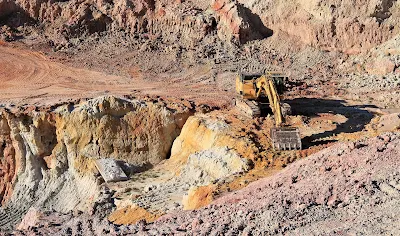What is an unconformity and its type?
What is an unconformity? To put it simply, an unconformity represents an interruption in the geologic record. This can occur during several different processes and events in the Earth’s history, so there are many different types of unconformities. In this article, we’ll break down the definition of an unconformity, give examples of some different types, and discuss how unconformities can be used to better understand earth history and other geological processes.
 |
unconformity definition-
What is unconformity?:
An unconformity is a boundary between two rock layers of different ages. They may be either angular or flat. Angular unconformities are also called disconformities because they represent time periods during which there was no deposition of sedimentary rock. Flat, or planar, boundaries between rock layers are simply called unconformities because they are not really gaps; they just represent periods of time when no sedimentary rocks were deposited.
Q: an unconformity is a buried ________.
Answer: erosional or non-depositional surface separating two rock layers or strata of different ages.
Types of Unconformities
Three types of unconformities that can be seen in outcrops around you:
(1)Non conformity,
(2) Angular unconformity, and
(3) DISCONFORMITIES
These terms may be applied to any sedimentary rock unit or rock layer, including strata (an exposed group of rocks) or a rock formation. Let’s take a look at each one individually
Non conformities
A structural unconformity usually occurs when rocks are uplifted by tectonic forces, exposing rock strata that were once buried deep underground. This kind of seismic event will leave large voids in a landscape. When these voids are filled in with new sediment deposits, an unconformity forms. If a layer of sedimentary rock was formed on top of metamorphic or igneous rock, it will be a disconformity instead; and if that layer has since eroded away, leaving only underlying sedimentary layers exposed, we would then call it a nonconformity. Nonconformities are often described as missing time periods in Earth’s history.
A nonconformity in geology describes a layer that lies above or below an earlier or later formation, without otherwise being part of it. Nonconformities represent time gaps in Earth history; they may occur between any two layers which are not conformable to each other, but there are no geological reasons why any specific point in time must be present as a nonconformity. For example, a Precambrian/Cambrian boundary could be missing due to erosion and therefore never deposited; such a boundary was removed from (eroded into) what became younger strata by some process other than purely physical erosion over geologic time scales.
Angular unconformity
This type of unconformity refers to erosional removal of older sedimentary rocks that are overlain by younger sedimentary rocks. Angular unconformities are very difficult to recognize because there may be no evidence at all of uplift, folding, faulting or erosion between different layers of rock. Angular unconformities represent time gaps in geologic history when deposition did not occur. This can occur over millions of years as continents collide with one another, pushing up mountains and pushing down troughs where sediments accumulate. tectonic unconformity: Tectonic (or structural) unconformities form when sediments are raised above sea level then subside as movement in Earth's crust forces them away from a coastline.
Disconformity
A disconformity is a gap in sedimentation. The geologic time period from one set of strata to another can be long enough for mountain ranges to grow up and erode away. Many layers can get eroded away during such periods. The presence of such an erosion layer is called a disconformity. For example, there are four types of disconformities recognized by geologists: pre-Mississippian disconformities (Ordovician), Mississippian (Devonian), Pennsylvanian (Permian) and Cretaceous–Paleogene (K/Pg). In all cases, missing rock layers represent millions of years.
What are the 3 steps that create an unconformity?
An unconformity exists when there is a break in time in which no sediments are deposited on top of another set of sediments. There are three steps that create an unconformity:
1) Existing sediment has to be eroded.
2) Newer sediment must be uplifted and/or redistributed.
3) Erosion must remove older existing sediment so that newer, younger sediment can be deposited over it. Because these events do not happen simultaneously they produce a break in time creating a physical unconformity. These events occur on different scales which produce different types of unconformities.
How unconformity is formed?
An unconformity is a break in deposition of sedimentary rock. The most common explanation for an unconformity is that there was time for erosion to take place before deposition began again, producing an unconformity. An unconformity represents a period of non-deposition or erosion and may be referred to as a nonconformity or inconsistency (see Inconsistency (stratigraphy)#Unconformities). Examples of nonconformities are quite common and occur after almost any period of erosion, extending from brief disruptions lasting only a few years to long periods such as those separating most Mesozoic rock units from overlying Cenozoic deposits.
Mismatches are periods of no deposits or active formation erosion. They help us understand that the geological record anywhere is NOT complete, but contains gaps. These are surfaces that form a significant gap (break) in the geological record between two rocky bodies (sometimes it is said in general terms that "time" is absent). These are surfaces between two rocky bodies that form a significant gap (hiatus) in the geological record (sometimes it is mistakenly said that "time" is absent).
Discontinuities represent moments when deposition was interrupted, an erosion interval removed some of the previously deposited rock, and finally deposition was resumed. Angular unconformities are those in which an older unit has been tilted, truncated by erosion, and a younger unit has been deposited on this erosional surface. The oldest layers of angular unconformity are tilted, eroded and exposed as the deposit surface and an unconformity sequence of younger layers settle on top of them. Angular mismatches are formed when the original horizontal layers deform, come to the surface, erode, and then are covered by newly deposited layers.
Angular unconformities form when rock deposited in a horizontal layer bends or tilts and is then eroded. An angular unconformity surface is an unconformity surface that is formed by horizontal and parallel sedimentary rock layers deposited on inclined and eroded layers, forming an uncoordinated angle with the overlying horizontal layer. An angular unconformity is an unconformity in which horizontally parallel layers of sedimentary rock are deposited on sloping and eroded layers, resulting in an angle mismatch with the overlying horizontal layers. An angular unconformity is an erosion surface that shears older dipping sedimentary sequences and is overlaid by younger sequences parallel to the unconformity.
An angular unconformity (figure) is the contact separating the younger, slightly submerged rock unit from the older underlying rocks, which are tilted or deformed bedrocks. An unconformity is a diffuse surface that separates the rocks above and below, which represents a gap in the rock record. A disparity is a surface between layers that represents a break in the record of time. A discontinuity is an erosive or non-deposited buried surface that separates two rock masses or layers of different ages, indicating that sediment deposition was not continuous.
Unconformities are buried eroded or undeposited surfaces that separate two rock masses or layers of different ages, indicating that sediment deposition is not continuous. Geological differences do not occur when rock layers become obsolete, but when older rocks deform or partially erode before younger sedimentary layers are deposited. An unconformity is a geological contact - a boundary between rocks - caused by a period of erosion or a pause in sediment accumulation followed by the deposition of new sediment. Mismatch occurs when erosion consumes rock or when rock deposits never form.
Therefore, there is a time gap between the formation of rocks below the dissonance and the formation of rocks above. Angular unconformities generally represent longer dwell times than unconformities because the underlying rock is usually metamorphosed, uplifted and eroded before the deposition of the upper rock unit. The movement of the Earth has tilted and may have bent the previously petrified rock, so the younger layers were later found to be unformable.
Soil often develops beneath an eroded surface, and some soil features may be preserved in rocks, leaving clues by which geologists can recognize old eroded surfaces. The presence of erosion provides strong evidence that uplift has occurred. Soil often develops below an erosive surface, and some soil features may be preserved in rocks, leaving clues by which geologists can recognize old erosive surfaces. Step #3 In step #3, resume deposition.
The beds were probably established during spawning shots, followed by intervals when nothing happened - no sign of disturbance, uplift or erosion. The litter is parallel on both sides of the contact, but evidence suggests that rupture (erosion, uplift) has occurred. In this figure, the discontinuity is visible in the erosional relief at the contact and in the older rock clasts in the younger layers. This indicates that the deformation of the older layers occurred before the storage of the upper layers.
The presence of sedimentary features, such as ripple marks in the vertical layers below the divergence, convinced Hutton that the vertical layers originally lay horizontally on the seafloor and that they were subsequently tilted, eroded, and resubmerged, with younger layers deposited above. non-compliance. Following the original law of horizontality and the law of superposition, both Hutton and Lyell recognized preserved erosional boundaries between rock layers that represent gaps in the geological record.
Discord is a discontinuity between parallel layers of sedimentary rock that represents a period of erosion or lack of deposition. Mismatches can also form when erosion removes a layer of rock after it has formed. Inconsistencies can form when deposits are not deposited in an area for a long time.
A mismatch occurs when these depositional conditions switch to an impure accumulation mode so that time-based sediment deposition ceases. In a gradual process similar to the other two mismatches, the sediment builds up and turns into rock. In the first stage, land-modified sediments transported to the sea accumulate on the seabed and transform into rock layers over millions of years. The Earth's cycle of formation and separation of the supercontinent uplifts and erodes incredible expanses of rock over long periods of time.
Over time, geologists and paleontologists have been able to match vast regions and even oceans with rocks and associated differences from other continents. It should be noted that gaps where the geological record of one region is inconsistent may be represented by sediments in another region.
They can be difficult to identify, often requiring rock dating using fossils or other methods to determine that the two rock layers are significantly different in age. Unconformities are unconformities that separate igneous or metamorphic rocks from overlying sedimentary rocks. Unconformities are breaks in rock sequences in a geological column.
Mismatch - An inconsistency or gap in a rock registration located between parallel rock strata. An angular unconformity is a type of rocky unconformity in which deposits of horizontally parallel layers of sedimentary rocks are formed on eroded and inclined layers of adjacent sedimentary rocks. As described above, the Tapeats sandstone layer in the Grand Canyon forms an angular unconformity where it spans the Grand Canyon slope series and an unconformity where it rests on the Vishnu Shale. Even miles away on the edge of the canyon, observers can see sloping rock layers sheared about 550 million years ago by a horizontal sedimentary layer called the Tapeats sandstone.
Although Darwin and others interpreted this widespread break in continental sedimentation as a failure of the geological record, this paleogeomorphic surface represents a unique physical boundary environmental condition that affected seawater chemistry during a period of significant expansion of marine habitats. First seen by John Wesley Powell in 1869 in the strata of the Grand Canyon, the Great Discontinuity is known to be missing rock from over a billion years ago.

